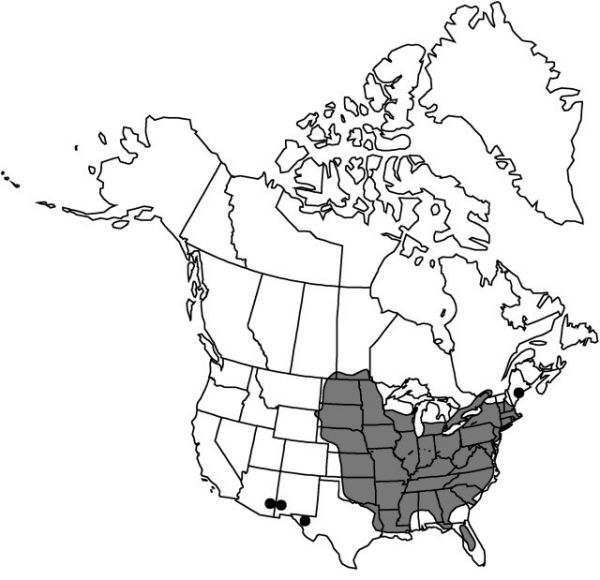Difference between revisions of "Polygonatum biflorum"
Sketch Bot. S. Carolina 1: 393. 1817.
FNA>Volume Importer |
imported>Volume Importer |
||
| (5 intermediate revisions by 2 users not shown) | |||
| Line 8: | Line 8: | ||
}} | }} | ||
|common_names=Giant Solomon’s seal | |common_names=Giant Solomon’s seal | ||
| − | |basionyms={{Treatment/ID/ | + | |special_status={{Treatment/ID/Special_status |
| + | |code=W2 | ||
| + | |label= | ||
| + | }} | ||
| + | |basionyms={{Treatment/ID/Basionym | ||
|name=Convallaria biflora | |name=Convallaria biflora | ||
|authority=Walter | |authority=Walter | ||
| + | |rank=species | ||
| + | |publication_title=Fl. Carol., | ||
| + | |publication_place=122. 1788 | ||
}} | }} | ||
|synonyms={{Treatment/ID/Synonym | |synonyms={{Treatment/ID/Synonym | ||
|name=Polygonatum biflorum var. commutatum | |name=Polygonatum biflorum var. commutatum | ||
|authority=(Schultes f.) Morong | |authority=(Schultes f.) Morong | ||
| + | |rank=variety | ||
}} {{Treatment/ID/Synonym | }} {{Treatment/ID/Synonym | ||
|name=Polygonatum biflorum var. melleum | |name=Polygonatum biflorum var. melleum | ||
|authority=(Farwell) R. P. Ownbey | |authority=(Farwell) R. P. Ownbey | ||
| + | |rank=variety | ||
}} {{Treatment/ID/Synonym | }} {{Treatment/ID/Synonym | ||
|name=Polygonatum cobrense | |name=Polygonatum cobrense | ||
|authority=A. Dietrich | |authority=A. Dietrich | ||
| + | |rank=species | ||
}} {{Treatment/ID/Synonym | }} {{Treatment/ID/Synonym | ||
|name=Polygonatum commutatum | |name=Polygonatum commutatum | ||
|authority=Farwell | |authority=Farwell | ||
| + | |rank=species | ||
}} {{Treatment/ID/Synonym | }} {{Treatment/ID/Synonym | ||
|name=Polygonatum giganteum | |name=Polygonatum giganteum | ||
| − | |authority= | + | |authority= |
| + | |rank=species | ||
}} {{Treatment/ID/Synonym | }} {{Treatment/ID/Synonym | ||
|name=Polygonatum melleum | |name=Polygonatum melleum | ||
| − | |authority= | + | |authority= |
| + | |rank=species | ||
}} | }} | ||
|hierarchy=Liliaceae;Polygonatum;Polygonatum biflorum | |hierarchy=Liliaceae;Polygonatum;Polygonatum biflorum | ||
| Line 55: | Line 68: | ||
-->{{#Taxon: | -->{{#Taxon: | ||
name=Polygonatum biflorum | name=Polygonatum biflorum | ||
| − | |||
|authority=(Walter) Elliott | |authority=(Walter) Elliott | ||
|rank=species | |rank=species | ||
| Line 69: | Line 81: | ||
|publication title=Sketch Bot. S. Carolina | |publication title=Sketch Bot. S. Carolina | ||
|publication year=1817 | |publication year=1817 | ||
| − | |special status= | + | |special status=W2 |
| − | |source xml=https:// | + | |source xml=https://bitbucket.org/aafc-mbb/fna-data-curation/src/2e0870ddd59836b60bcf96646a41e87ea5a5943a/coarse_grained_fna_xml/V26/V26_364.xml |
|genus=Polygonatum | |genus=Polygonatum | ||
|species=Polygonatum biflorum | |species=Polygonatum biflorum | ||
Latest revision as of 21:14, 5 November 2020
Rhizomes deeply set, 1–3 cm thick. Stems erect to arching, 5–20 dm; sheathing bract usually absent. Leaves sessile to clasping, (5–)9–20(–25) × 3–9(–13) cm; blade narrowly lanceolate to broadly elliptic, glabrous; prominent veins 1–19. Inflorescences in most leaf axils except distal 2–3 and proximal 2–7; peduncle flattened, not strongly reflexed, axillary 2–10(–15)-flowered, 6–9 cm in fruit. Flowers: perianth whitish to greenish yellow, tube (13–)17–22 mm, distinct tips gently spreading, 4–6.5 mm; stamens inserted near middle of perianth tube; filaments glabrous, sometimes minutely warty; pedicel 1–4 cm in fruit. Berries 8–12 mm. 2n = 20, 40.
Phenology: Flowering early–late spring.
Habitat: Dry to moist deciduous woods, in sandy soil, roadsides, railway embankments, old fields
Elevation: 0–3000 m
Distribution

Man., Ont., Que., Sask., Ala., Ariz., Ark., Conn., Del., D.C., Fla., Ga., Ill., Ind., Iowa, Kans., Ky., La., Maine, Md., Mass., Mich., Minn., Miss., Mo., Nebr., N.H., N.J., N.Mex., N.Y., N.C., N.Dak., Ohio, Okla., Pa., R.I., S.C., S.Dak., Tenn., Tex., Vt., Va., W.Va., Wis., Wyo., ne Mexico.
Discussion
As a polyploid complex, Polygonatum biflorum is variable as to plant size, flower number, and ecology. Tetraploids, which have been recognized as var. commutatum, are usually larger and coarser than diploids, var. biflorum, with more flowers per peduncle and more major veins per leaf. They have also been called P. commutatum, P. giganteum, and P. canaliculatum (Mühlenberg) Pursh (misapplied). Some diploids, however, are fully as large as any tetraploids. Range-wide separation of species has been problematic (R. P. Ownbey 1944; E. G. Voss 1972–1985; J. A. Steyermark 1963; G. Yatskievych 1999+), while local distinction may be possible (M. L. Fernald 1944b; M. W. Richardson and D. Ugent 1974). Detailed molecular and enzymatic analysis at the population level is needed range-wide, in conjunction with karyological and morphological study.
Local populations of Polygonatum biflorum with honey-yellow flowers from southeastern Michigan and adjacent Ontario (E. G. Voss 1972–1985; R. P. Ownbey 1944) have been recognized as var. melleum. Disjunct populations in the trans-Pecos Texas and the mountains of Arizona and New Mexico have been called P. cobrense.
Selected References
None.